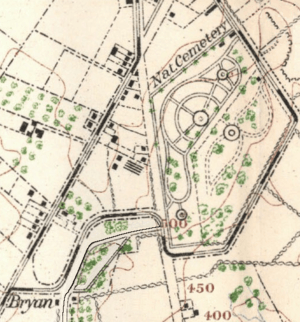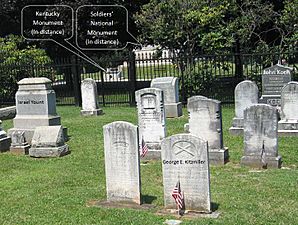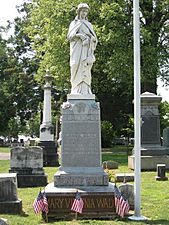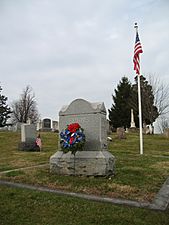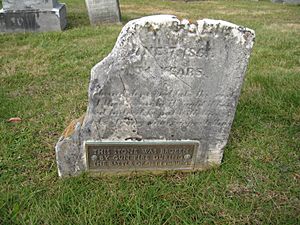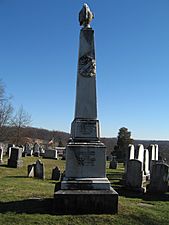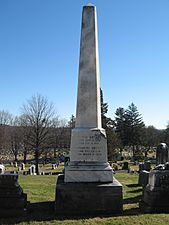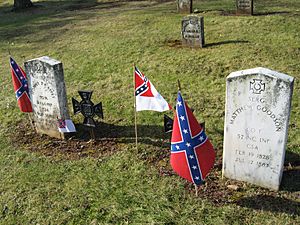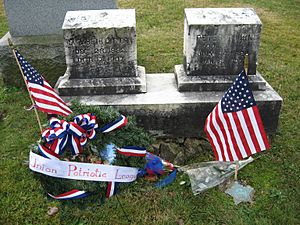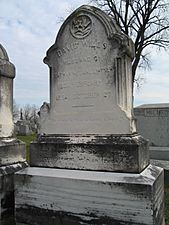Evergreen Cemetery (Adams County, Pennsylvania) facts for kids
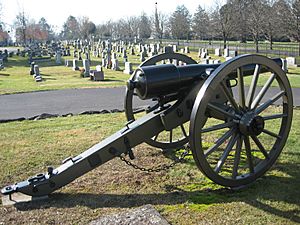
Ginnie Wade Monument, location of platform for Gettysburg Address and Soldiers National Monument (L to R) are marked on the horizon. The oldest section (A) of the cemetery appears behind the Parrott rifled cannon.
|
|
| Lua error in Module:Location_map at line 420: attempt to index field 'wikibase' (a nil value). | |
| Details | |
|---|---|
| Established | 1854 |
| Location |
Cumberland Township, Adams County, Pennsylvania
|
| Country | United States |
| Size | 17.65 acres (7.14 ha) |
Evergreen Cemetery is a historic burial ground located near Gettysburg, Pennsylvania. It's a large cemetery, about 29 acres, and is part of the famous Gettysburg Battlefield Historic District. It sits right next to Gettysburg National Military Park and the Soldiers' National Cemetery.
This cemetery played a very important role during the Battle of Gettysburg in July 1863. Four months after the battle, President Abraham Lincoln gave his famous "Gettysburg Address" from a platform located within Evergreen Cemetery.
Contents
History of Evergreen Cemetery
How Evergreen Cemetery Started
The Ever Green Cemetery Association of Gettysburg was created in November 1853. This group managed the cemetery and chose its caretakers. By April 1854, many burial plots had already been sold. The first person was buried there on October 29, 1854.
The cemetery officially opened on November 7, 1854. During the opening ceremony, Reverend John H. C. Dosh asked, "Could a more lovely spot have been chosen?"
The Evergreen Cemetery gatehouse was designed by an architect named Stephen Decatur Button. Local builders finished it in November 1855. This beautiful Italian-style building served as the home for the cemetery's caretaker.
Evergreen Cemetery During the Battle of Gettysburg
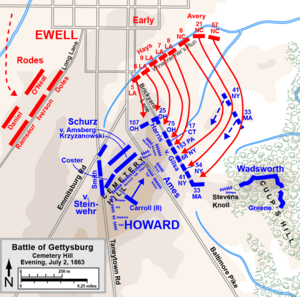
Evergreen Cemetery is located on a high piece of land called Cemetery Hill. This spot was very important for the Union army during the Battle of Gettysburg. Major-General Oliver Otis Howard placed cannons on this high ground, turning it into a strong "artillery platform." He also made the cemetery's gatehouse his army headquarters.
On the evening of July 2, 1863, Confederate soldiers attacked the Union cannons from the east. This attack became known as the Battle of East Cemetery Hill. Union soldiers in the cemetery moved many tombstones to the ground to protect them. Some soldiers even used the grave markers for cover from enemy fire.
A historian named Frederick Hawthorne wrote that Union soldiers hiding in the cemetery rushed out to help push the Confederates away from the cannons. The Union army successfully defended this important position.
After three days of fighting, the cemetery was badly damaged. One Union officer sadly wrote that the "beautiful cemetery" was "trodden down, laid a waste, desecrated." Fences were broken, graves were run over, and monuments were damaged. He noted that soldiers and cannons occupied the "sacred grounds where the dead are sleeping."
Two Confederate soldiers who were badly wounded during the battle were buried in Evergreen Cemetery.
After the Battle: Lincoln's Address and Expansion
The dedication of the National Cemetery happened on November 19, 1863. The platform where Edward Everett and President Abraham Lincoln gave their speeches was located in Evergreen Cemetery, just east of the National Cemetery. This is where Lincoln delivered his famous Gettysburg Address.
From 1893 to 1916, a trolley line called the Gettysburg Electric Railway ran along the east and south sides of the cemetery. After the trolley line was removed in 1917, Evergreen Cemetery expanded its land to the south.
In 1972, the "Evergreen Cemetery archway house" was recognized as an important historic building by the Gettysburg Borough Council. In 1992, civilian remains from an older church cemetery were moved and reburied at Evergreen Cemetery.
Photo gallery
-
Ginnie Wade was the only civilian killed during the Battle of Gettysburg.


